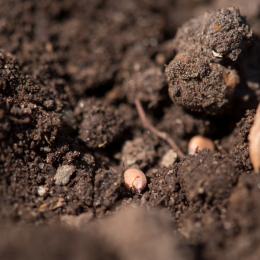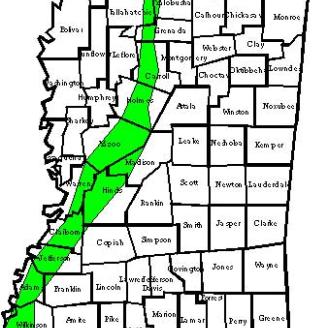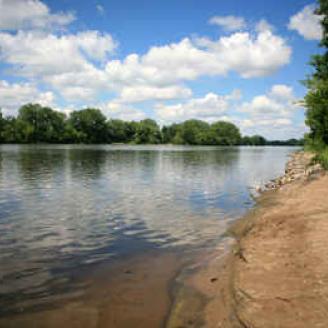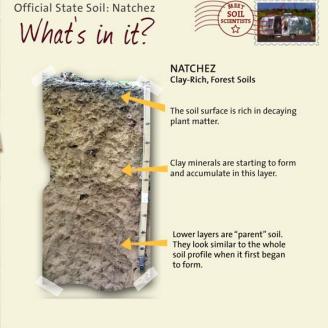

“To be a successful farmer one must first know the nature of the soil.”
Mississippi NRCS delivers science-based soil information to help farmers, ranchers, foresters, and other land mangers effectively manage, conserve, and appraise their most valuable investment.
Mississippi State Soil: The Natchez Silt Loam
In 1988, the Professional Soil Classifiers Association of Mississippi selected Natchez silt loam soil to represent the soil resources of the State. These soils exist on 171,559 acres (.56% of the state) of the landscape in Mississippi.
The Natchez soils formed in very deep loess; material under a woodland environment and a climate that was warm and humid. These soils have natural fertility and desirable tilth but usually, occur on slopes that limit their use to trees. In areas where slopes are less, pasture and row crops are grown, and the soil is very productive when good management is applied.
A typical Natchez soil profile consists of a 3-inch topsoil of dark grayish brown silt loam and to 8 inches, a subsurface of brown silt loam, a yellowish brown and dark yellowish brown silt loam subsoil to 36 inches and a substratum that is yellowish brown, and dark yellowish brown silt loam down to 80 inches.
Soil Family Classification: Coarse-silty, mixed, super active, thermic Typic Eutrudepts:
Natchez soils are in the Inceptisols soil order. Inceptisols soils have developed in relatively young material that has an Ochric epipedon overlying a Cambic horizon. This soil is developed in very deep wind-blown loess that is rich in weatherable minerals. The term coarse-silty indicates that the subsoil has less than 18 percent clay with less than 15 percent sand coarser than very fine. The term mixed suggests that no one mineral is over 60 percent. Thermic refers to an average annual soil temperature between 15-22 degrees C (59-72 degrees F) and differs more than 5 degrees C between winter and summer at 50 cm (20 inches) below the surface.
Natchez soils are on strongly sloping to very steep hillsides in the highly dissected parts of the bluff hills that border the Mississippi Delta floodplains. They formed in silty loess material that ranges from strongly acid to neutral in the upper part and neutral to slightly alkaline in lower parts. Average annual precipitation is 52 inches. Average annual air temperature is 63 degrees F. The soil has developed in the upper Pleistocene age material.
On March 13, 2003, Mississippi lawmakers designated the Natchez Silt Loam as the official state soil.
(Approximate graphic distribution of the Natchez Soils of Mississippi)
What is Soil Health?
Soil health is defined as the continued capacity of soil to function as a vital living ecosystem that sustains plants, animals, and humans. Healthy soil gives us clean air and water, bountiful crops and forests, productive grazing lands, diverse wildlife, and beautiful landscapes. Soil does all this by performing five essential functions:
- Regulating water
Soil helps control where rain, snowmelt, and irrigation water goes. Water flows over the land or into and through the soil. - Sustaining plant and animal life
The diversity and productivity of living things depends on soil. - Filtering and buffering potential pollutants
The minerals and microbes in soil are responsible for filtering, buffering, degrading, immobilizing, and detoxifying organic and inorganic materials, including industrial and municipal by-products and atmospheric deposits. - Cycling nutrients
Carbon, nitrogen, phosphorus, and many other nutrients are stored, transformed, and cycled in the soil. - Providing physical stability and support
Soil structure provides a medium for plant roots. Soils also provide support for human structures and protection for archeological treasures.





